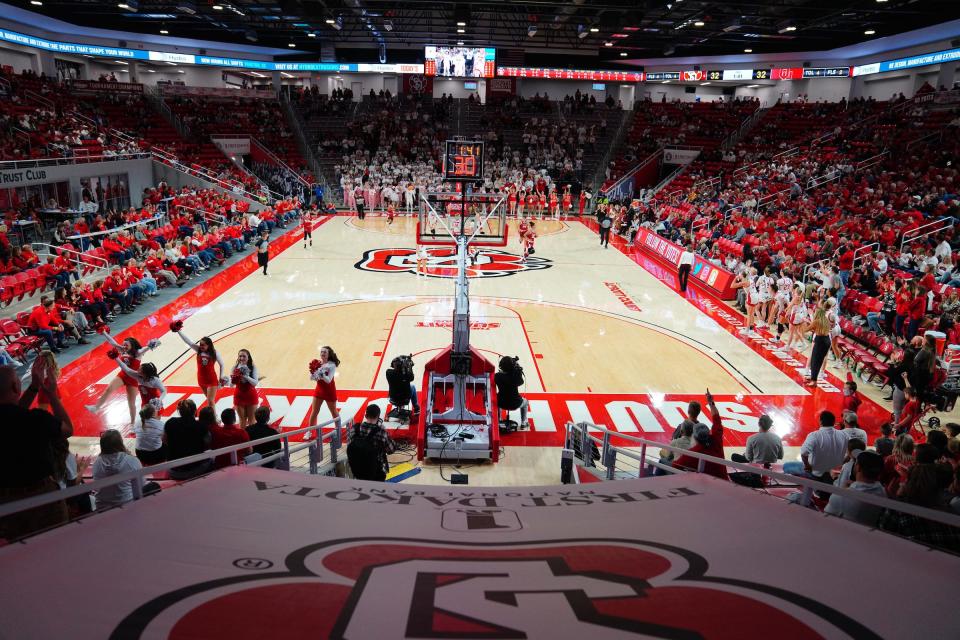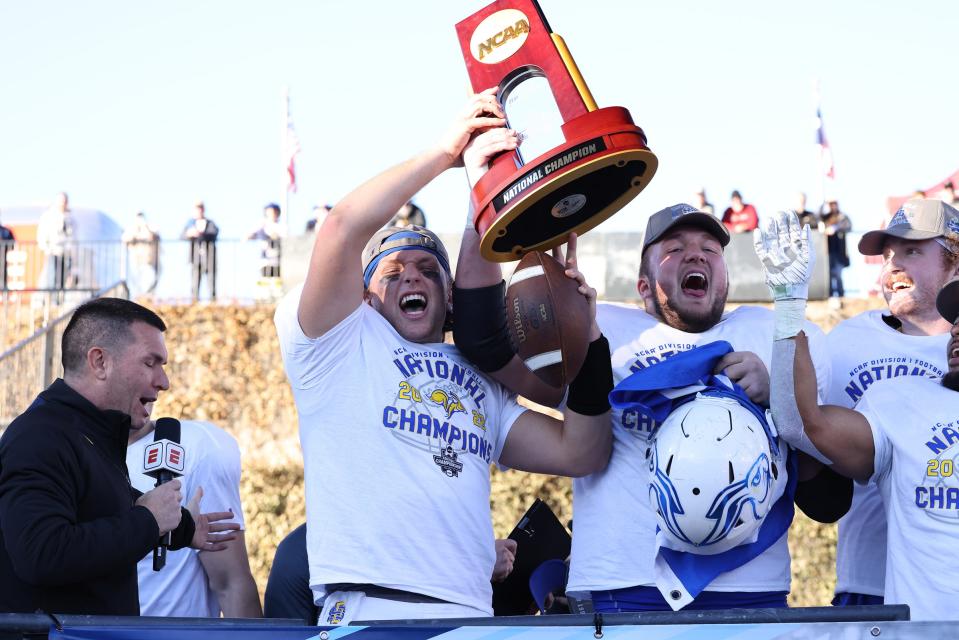SDSU, USD rely heavily on state money and student fees to subsidize Division I athletics
As the clock struck zero at the 2012 Summit League basketball finals, South Dakota State University fans stormed the Sioux Falls Arena court to celebrate their men’s team’s first-ever bid to one of America’s most significant sports spectacles, the NCAA Division I tournament.
Coupled with SDSU’s women’s basketball triumph earlier on the same court, the moment seemed to bolster the Brookings school’s decision eight years earlier to leave the familiar confines of the Division II North Central Conference to compete at the highest level of intercollegiate sports.
“It was one of those days,” said SDSU athletic director Justin Sell, “that changed our university.”

Like most everything in the increasingly complex world of college athletics, however, there was more to the story. Besides winning, SDSU sought to keep the athletic program financially viable and less reliant on taxpayer money, university support and student fees.
Two years later, the University of South Dakota in Vermillion announced its own jump to Division I and began a similar journey to depend less on those allocated funds, as they’re known in NCAA circles.
More:Myah Selland helps SDSU earn overtime win against USC in first match of NCAA tournament
According to a South Dakota News Watch analysis of mandatory NCAA reporting data over the past decade, the Jackrabbits’ Division I reclassification in 2004 has been more successful in that regard:
· SDSU, with an athletic budget of $20 million, draws about 45% of its revenue from allocated funds, according to the most recent data.
· USD’s athletic department is more subsidized, with 66% of its $18.5 million budget coming from government and institutional money and student fees.
Government support refers to general funds disbursed by the South Dakota Board of Regents, which oversees the state’s six public universities. Institutional funds can include money from tuition, tuition waivers and endowments.
SDSU and USD compete in the Summit League for most sports and are football members of the Missouri Valley Conference along with North Dakota State and the University of North Dakota.
That puts them in the Football Championship Subdivision (FCS), a lower level than the Football Bowl Subdivision (FBS), which encompasses major-college programs such as Nebraska, Minnesota and Iowa.

The so-called Power Five conferences – the Atlantic Coast (ACC), Big Ten, Big 12, Pacific-12 (Pac 12) and Southeastern (SEC) – reap the benefits of billion-dollar television deals and ticket sales. Their allocated funds average is 7%, due mainly to media rights, NCAA and conference distributions and bowl-related revenues that create a “haves and have nots” chasm in college athletics.
That leaves mid-major programs such as SDSU and USD scrambling to find enough money to meet mounting expenses for scholarships, coaches compensation, facilities and travel. Operating revenue such as ticket sales, corporate sponsorship and donor contributions can be a challenge for mid-major athletic programs to generate.
When compared with rivals, the South Dakota schools are not unique, according to the News Watch analysis of NCAA data from 2012-2020 (fiscal year 2021 was disregarded due to COVID-related impacts):
· The average percentage of allocated funds for FCS schools is 71%, which means USD is less subsidized than most schools at their competitive level.
· Other Summit League public schools that sponsor football also rely heavily on allocated funds: North Dakota State (33%), North Dakota (54%) and Western Illinois (72%).
· SDSU reported $4.4 million in ticket revenue in 2020, compared with $960,000 for USD.
· NDSU reported $6.3 million in ticket sales in 2020, while UND had $4.9 million (including Division I hockey) and Western Illinois $900,000.
· Northern Colorado, a former NCC school that reclassified to Division I in 2002, drew 70% of revenue from allocated funds in 2020 and brought in just $339,500 in ticket sales.

USD’s reliance on allocated funds has increased nearly 100%, from $6.58 million in 2012 to $13.08 million in 2020. SDSU went from $7.88 million to $9.9 million during that span, a rise of 27%.
Academic spending at USD increased 23% from 2012-20 ($164.1 to $202.6 million), while SDSU’s spending increased 12% during that span ($163.6 to $183.4 million). Those expenditures include instruction, research, public service, academic support and student services.
On the athletics side, increased funding to meet Division I demands has not produced higher enrollment. In fact, SDSU’s undergraduate enrollment dropped 10.7% from 2012 to 2023, while USD’s dipped 4.6%. Tuition more than doubled at both schools during that span from $114.30 a credit hour to $256.55, a spike of nearly 125%.
More:How South Dakota State women's basketball stack up against USC ahead of the NCAA game
Brian Maher, Board of Regents executive director, was asked if the board was concerned about one of the state’s Division I universities being more reliant than the other on public and student subsidies.
“We always have to look at how equitably we are treating like institutions, and we will continue to look at that,” said Maher. “Is there a concern? I would say, always. Are we overly concerned right now? No, but I do think we need to look at making sure the balance is there and, if not, is it time to re-balance? I think we always need to look at that.”

“A lot of schools can’t drive the revenue,” added SDSU’s Sell. “Is one model better than one another, is one good or one bad? I don’t know. They’re just different. Each school philosophically has to figure that out, and ultimately it’s your constituents, students and supporters that need to feel comfortable with that approach.”
The Jackrabbits and Coyotes have seen their share of sports success, with SDSU’s football team claiming its first-ever national title this past season and USD’s women’s basketball advancing to the Sweet 16 of the NCAA tournament in 2022.
SDSU won the Summit League women’s basketball tournament in Sioux Falls last week and will compete in the NCAA tournament for the 11th time since making the move to Division I. The Coyotes’ track and field program has produced four NCAA individual pole vault titles.
How has that success translated into meeting the financial demands of fielding competitive teams and creating a rewarding experience for student-athletes and their fans?
USD president Sheila Gestring pointed to renewed efforts to market the school’s sports teams and improve game day experience to boost interest. She also noted that Division I sports can bring exposure to a university that goes beyond turnstile counts.
“There is value involved in getting national exposure,” Gestring told News Watch. “You can’t buy enough marketing to match the free coverage you’re getting when you’re making a march to win the WNIT (Women’s National Invitation Tournament) or get to the Sweet 16, or you have an Olympic silver medalist or Sports Illustrated play of the year. It’s a tremendous way to expose not just your athletic teams to a national audience, but the university in general.”
More:South Dakota State men's basketball survives thriller vs. South Dakota with late-game heroics
Gestring spoke those words several days after watching USD’s basketball teams bow out in the first round of the Summit League tournament, the women dealing with the departure of coach Dawn Plitzuweit, who guided the Coyotes to three Summit tourney titles, to West Virginia of the Big 12. The USD football team is coming off a season with three wins and eight losses, reinforcing the notion that selling your school’s Division I vision to donors and fans is easier on the heels of victory.
“There’s a certain amount of revenue that comes with winning, and I think that’s how you fill the gap,” said Maher. “Otherwise, to use a phrase from athletics, ‘You’re just another guy.’”
— This article was produced by South Dakota News Watch, a non-profit journalism organization found online at sdnewswatch.org.
This article originally appeared on Sioux Falls Argus Leader: SDSU, USD rely heavily on state money and student fees to subsidize Division I athletics

